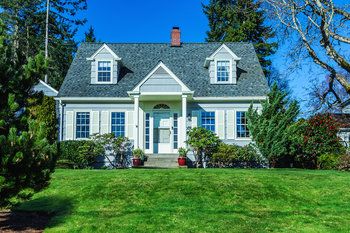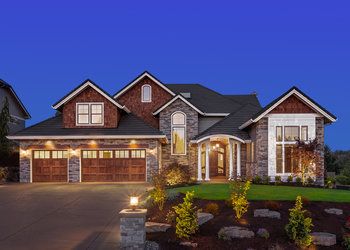 Do you live in a typical American home? Do you want to? Or do you aspire to something better? Or perhaps you'd prefer something more modest: one that's more sustainable for both the environment and your pocket.
Do you live in a typical American home? Do you want to? Or do you aspire to something better? Or perhaps you'd prefer something more modest: one that's more sustainable for both the environment and your pocket.
See mortgage rates for typical and unique homes
Typically unique
Of course, every home is unique, including yours. Even if you just bought one in a developer's tract, yours will have characteristics none of the others share. To start with, its plot shape and size will likely be different. And, if you bought off-plan or during construction, maybe you chose some or all of the finishes.
And you'll slowly stamp this home with your own décor and furnishings. Even if it didn't start out that way, your place is going to end up a unique reflection of you.
But that doesn't mean it can't be typical, too. How does your property compare with the average American home? Read on to find out.
Related: Is it Better to Buy a New or Used Home?
Average home size in the US
In 1970, the median size of new single-family homes was just 1,500 square feet, according to the US Census Bureau. By 2010, it had grown to 2,169 square feet. And, by 2020, the median size of a new home sold had bloated to 2,333 square feet. Who in 1970 would have believed that a newly built typical American home sold to a buyer some 50 years into the future would have 55% more square footage than the brand-new home they just purchased?
There's another even more startling factor to take into account. The Census bureau notes that the average size of a household in 1970 was 3.14 people, meaning the home offered 477 square feet per person. But by 2020, that household had shrunk to 2.53 people. And each had 926 square feet in which to stretch out, about double the space available in 1970.
Why the extra space?
There may be an obesity epidemic in America... but 926 square feet of living space each? That's about the size of a large apartment for each person! Obviously, there are other factors in play here.
We've changed what we want from our real estate, and many see the size of their home as the biggest luxury a house can deliver. Finished basements as guest suites are no longer rare. Many want a study or home office -- often matching his-and-hers, and especially after the work-from-home shift from the COVID-19 pandemic. Your master suite is nothing if it's not huge. Your walk-in closet today might be bigger than the bedroom you had as a child. And it's not a master "suite" without its own adjoining bathroom.
Then there are the man caves, she sheds, and bonus rooms -- open space, often on a second floor or wing, where kids can play, work or watch TV without being a nuisance. Ah, the joys of modern parenting.
There's no doubt that new construction projects -- even teardown and rebuilds -- often are comprised of or create larger homes. Given land cost, permitting and more, it's more profitable for home builders to build larger single-family houses, even with the increased cost for material.
Related: The Income You Need to Buy a Median-Priced Home in the Top 50 Metro Areas
Average home price in the US
You may have barely noticed the ballooning size of homes. But higher home prices have certainly claimed your attention.
The average median sales price of existing (not newly built) homes was $295,200 in 2020, according to data from the National Association of Realtors. For the year, the NAR reported that the average house size of an existing home sold that year was 1,900 square feet. The US Census says the average median price for a newly-constructed home sold in 1970 was $23,533. By 2020, a newly-constructed home sold for a median price of $336,900.
Higher home prices through inflation... and much, much more
Of course, median family income was just $9,867 in 1970, while it was $84,008 in 2020, again based on Census data. And it's likely even higher now.
Still, incomes rose only about 750% between 1970 and 2020, but new home prices spiked over 1,300%. Much of that increase in the average home price in the US is due to the increased size of homes and ever-rising land costs.
The table below shows that the price per square foot of the typical home didn't increase by much more than annual income did -- 821% vs 751%. So we pay more because we buy larger houses.
| 1970 | 2020 | Change | |
| Income | $ 9,867 | $84,008 | 751% |
| Home Price | $23,533 | $336,900 | 1,331% |
| Size | 1,500 | 2,333 | 156% |
| Price / Sq Ft | $15.68 | $144.40 | 821% |
Even as the square footage of a house has increased by 156%, there is still a 70% difference in home value unaccounted for; this is likely due the extra demands we put on our houses. We want greater functionality from our houses; yesterday's "luxury" amenities (en-suite baths, laundry rooms, and home offices) are standard stuff these days. Not to mention smart appliances, home security, energy efficient windows, landscape architecture and other gee-whiz features. We pay for that.
And some of the increase can likely be attributed to population growth, increased demand in areas that are already built out, and concentrations of high paying jobs (like software development) in areas with limited housing opportunities.
Popular home features
So what are those amenities, features and technologies that so many look for in a new home? The US Census listed the percentage of 2020's 822,000 new single-famiy sold homes having these popular features:
- Air conditioning 789,000 (96%)
- Four bedrooms (or more) 430,000 (52%)
- Three or more bathrooms 300,000 (36%)
- Deck, porch or patio outside: 760,000 (92%)
- Full or partial basement 175,000 (21%)
- Gas as a primary heating fuel 495,000 (60%)
Other popular home features for recent buyers include laundry rooms, garages with storage space, hardwood floors, walk-in pantries and exterior lighting. Another increasingly desirable item on the list is an energy-efficient home.
Do you have all or some of those? At last, you have a yardstick. So you can answer that burning question: Is yours a typical American home?
This article was updated by Keith Gumbinger.



